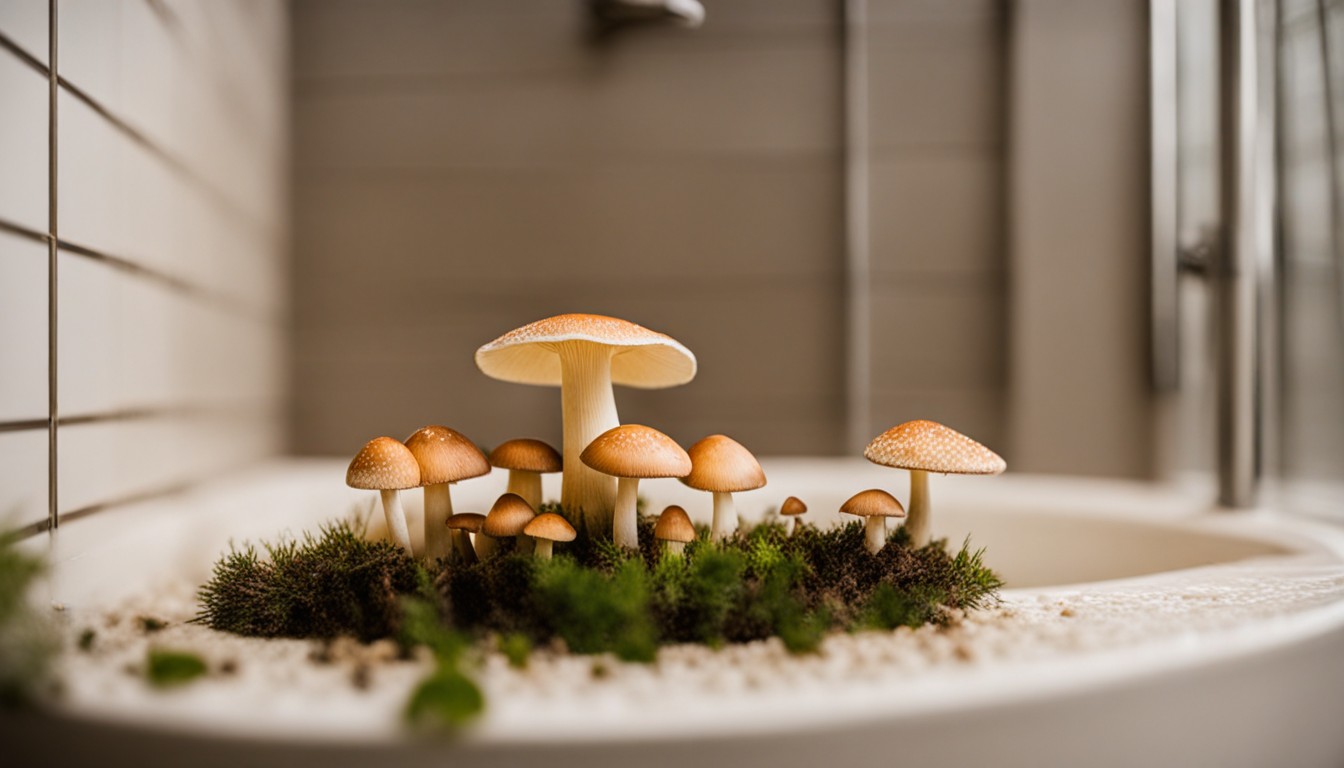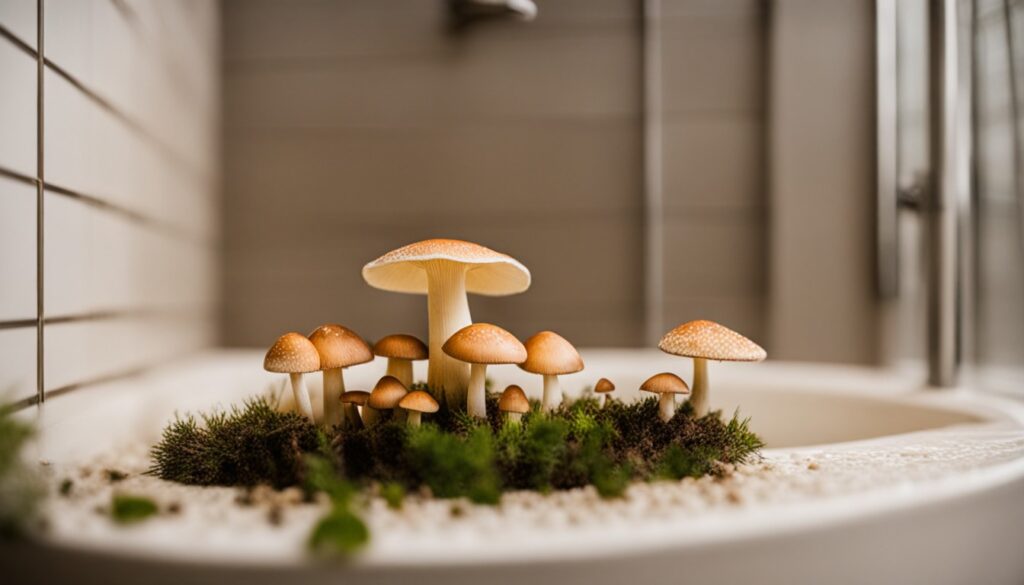Mushrooms growing in the shower can be a frustrating and unsightly problem for many homeowners. In this blog post, we will explore the various causes of mushrooms in the shower and provide effective remedies to prevent their growth. From understanding the underlying moisture issues to implementing proper ventilation and cleaning techniques, we will guide you through the step-by-step process of eliminating and preventing mushrooms in your shower. With our expert advice and attention to detail, you can say goodbye to those unwanted fungi and enjoy a clean and fungus-free shower space.
Why Mushrooms Grow in Showers
Mushrooms sprouting in your shower may seem odd, yet it’s actually a sign of ideal conditions for fungi growth. The humidity, warmth, lack of sunlight, organic material presence, and poor ventilation converge, creating the perfect environment.
Mushrooms don’t just invade shower spaces on their own; they require carriers. Invisible to the naked eye, mushroom spores travel through the air, latch onto damp surfaces, and thrive when conditions align, leading their steady growth in the confines of your shower.
Ideal moisture levels
The proliferation of mushrooms in showers is largely due to elevated moisture levels, as these environments are notorious for high humidity. This creates an inviting habitat favoring fungal growth.
- Elevated moisture levels: Moist environments provide ideal conditions for mushrooms to thrive and reproduce.
- High humidity: Ensures that there is a sufficient water source for the fungus to grow and spread.
Warm and damp environment
A warm and damp environment presents ideal conditions for mushroom growth. This occurs when hot water from shower use elevates room temperature and humidity, creating a nurturing microclimate for fungi.
- Increased room temperature due to hot showers.
- Availability of humidity due to steam.
- Consistent dampness due to lack of adequate drying after a shower.
- Promotion of spore dispersion and germination under heated conditions.
Poor ventilation
Poor ventilation plays a crucial role in mushroom growth in the shower. The lack of air circulation creates a stagnant and humid environment, making it a fertile breeding ground for bathroom fungi.
- Facilitates spore dispersal for mushroom reproduction
- Creates a humid environment favorable for fungi
- Prevents the rapid drying of shower surfaces
- Supports the condensation of bathroom steam into water droplets
- Keeps organic material damp, providing food for the fungi
Presence of organic material
The infestation of mushrooms in showers can be directly attributed to the presence of organic material. Organic residues such as soap scum, shampoo residue, or even tiny fragments of skin effectively act as food source for these fungi.
- Soap scum build-up
- Shampoo residue
- Tiny fragments of skin
- Household dirt and grime
- Decaying matter
Lack of sunlight
Limited exposure to sunlight greatly influences the proliferation of mushrooms in showers. These fungi, often showing a preference for dimly lit areas, tend to flourish in sun-starved bathroom corners where the conditions are ideal for their growth.
- Prevention of photosynthesis, making bathrooms a conducive environment for fungi
- Dimly lit showers mimicking the natural habitat of certain mushroom species
- Lack of sunlight promoting conditions that support the fungi’s life cycle and growth
- Sun-starved corners providing an environment devoid of ultraviolet light which would otherwise inhibit fungi growth
Types of mushrooms found in showers
Predominantly, the types of mushrooms thriving in your shower are fungi such as mold and mildew. With an uncanny ability to flourish in damp, warm environments, these types are commonly found in bathrooms.
Mold and mildew are forms of fungi commonly found in showers, and they pose potential health hazards if unchecked. This highlights the importance of regular and thorough bathroom cleaning.
Most frequently encountered is perhaps the black mold, scientifically known as ‘Stachybotrys chartarum’. This type is notorious for its quick propagation and potential health hazards, particularly respiratory issues.
Another frequently found species is the pink mold, technically a bacteria, ‘Serratia marcescens’. Despite its categorization, it behaves like a fungus, thriving on bathroom surfaces frequently doused with water.
One should not overlook the ‘Aspergillus’ species. Though less common in showers, this ubiquitous mold is known for its ability to grow on a wide range of organic material, and could cause severe health issues, particularly in those with a compromised immune system.
Dangers and Risks of Shower Mold

Mushrooms and molds in your bathroom not only mar its appearance but also pose unnoticed health hazards. The spores released can activate allergic reactions, trigger respiratory problems, and potentially launch more serious health issues.
Ignoring such fungal infestations in the shower can usher in grave threats. Besides causing structural damage to the bathroom, these molds tend to spread across the house, inviting further health complications and repair costs.
Allergic reactions
Just like pollen or dust, various species of mushroom spores can readily trigger allergic reactions. As these spores circulate around your bathroom, their inhalation or physical contact can lead to discomfort or even health risks.
These bathroom mushroom spores are carriers of allergens. The damp and moist environment of a bathroom encourages the proliferation of these irritants, making them potent triggers for an allergic response.
The allergenic nature of these mushrooms depends primarily on their spore content. Over time, these microscopic particles permeate the air in your household, increasing the potential for undesirable immune responses.
Allergy symptoms provoked by bathroom mushrooms can include sneezing, itching, and even skin rashes. For those particularly vulnerable to allergy symptoms, these reactions can be severe and persistent, warranting immediate action.
Respiratory issues
Shower mushrooms, interesting yet potentially dangerous, contribute significantly to respiratory problems. Spores disseminated by these fungi become airborne, eagerly inhaled by the unwary, leading to a host of lung-related issues.
The unsuspecting homeowners, ignoring shower mold, unknowingly invite these silent perpetrators. Prolonged exposure to mold may cause bronchitis, pneumonia, and even aspergillosis, a serious condition that affects the respiratory system.
Chronic respiratory issues can manifest in individuals who frequently breathe in mold spores. Symptoms such as chronic cough, difficulty breathing and wheezing can prevail, giving mold a foothold in your lungs.
Effective measures to minimize exposure and restrict growth of these mushrooms are critical. The silent perpetuation of unseen respiratory problems can be halted, affording healthier air and a better life for you and your family.
Structural damage to the bathroom
Prolonged invasion of mushrooms in bathrooms can lead to substantial structural damage. Porous materials such as grout, wood, and drywall are particularly susceptible, absorbing moisture, facilitating fungal growth and eventual decay.
A clear correlation exists between shower mushrooms and accelerated bathroom wear and tear. High humidity conditions allowing fungal growth also hasten deterioration of fixtures and finishes.
Unfortunately, the damage often extends beyond visible growths. Hidden behind tiles and within wall cavities, the invasive fungi can compromise structural integrity, necessitating costly repairs or replacement.
Potential health hazards

Extensive mushroom growth in bathrooms often cloaks an underbelly of hidden health risks. Coupled with poor ventilation, these health hazards can range from minor to severe, affecting both daily comfort and long-term wellbeing.
Airborne mushroom spores, released into the environment during decomposition, can pose a threat to residents. Frequent exposure may lead to unpleasant skin irritations, exacerbating conditions such as eczema and dermatitis.
In addition to skin irritations, these spores can also induce respiratory issues. Symptoms might include coughing, wheezing, and in severe cases, the development of more serious lung diseases.
Moreover, if spore-laden dust particles are ingested or inhaled, they can potentially cause systemic mycoses – infections that affect the entire body. Recognizing these potential hazards is key to promoting a healthier living environment.
Spreading to other areas of the home
Unchecked mushroom spread in your shower can quickly invade adjoining home spaces. The spores, once airborne, latch onto surfaces in other areas, marking the beginning of a relentless invasion.
Mushrooms have an uncanny propensity to colonize humid conditions similar to the bathroom’s environment. Therefore, spaces like the kitchen or laundry room are often the next stepping-stones in their expansive march.
Over time, patterned mushroom colonization suggests an increased likelihood of them appearing in adjacent rooms with relative humidity above 70% and temperatures of 68°F (20°C) or above.
As the mushrooms prosper, they can potentially destroy not only the aesthetics of the space but also the structural integrity of your walls, ceilings, and floorings, particularly in built areas with organic materials.
Ultimately, recognizing the danger signals early can halt the spread of these unwanted guests. Diligent monitoring and rectifying conditions conducive to mushroom growth is key to maintaining a fungi-free household.
Effective Remedies for Mushrooms in Showers
Providing a comprehensive guide, we tackle shower mushrooms effectively, enlisting both tried-and-tested remedies and preventive measures. In this text it’s discussed the importance of mushroom elimination, addressing underlying moisture issues, improving ventilation, use of mold-resistant materials, and consistent bathroom maintenance to curb the growth of these uninvited organisms.
Remove the mushrooms
For safe removal of mushrooms, become adept in efficient techniques, such as using a soft brush and a solution of vinegar and water. It minimizes risks while ensuring cleanliness.
Ensure to wear protective gloves and masks when handling fungi to prevent any possible health complications. Dispose of them in a sealed bag to prevent further contamination.
An easy mushroom eradication technique involves the use of a naturally antifungal spice — clove oil. Simply mix with water in a spray bottle and apply liberally to the infected area.
Bleach diluted with water can also be an effective agent for mushroom removal. However, only employ this technique in well-ventilated spaces due to the strong chemical fumes.
Always confirm complete removal of the mushrooms, including their roots. Incomplete removal might promote a quicker re-infestation.
Address the underlying moisture problem
To prevent mushroom flourishing, unseen dampness must be regularly dealt with. Seek out and rectify invisible leaks, unattended spills, or elevated humidity levels lurking within the bathroom settings. Remember, water should have an exit pathway other than evaporation into your home air.
Excess moisture is the silent accomplice in mushroom proliferation in showers. By establishing effective moisture management strategies like using dehumidifiers or air movers, you can maintain a dry environment that’s unfavorable for mushroom growth.
Improve ventilation
Bolstering airflow emerges as a noteworthy strategy in deterring the proliferation of mushrooms in your shower. It’s essential to keep in mind that stagnant, humid air fosters the growth of these unwelcome fungi. Consequently, implementing systems to increase air movement is a crucial step in halting mushroom growth.
Ventilation systems, such as exhaust fans, can provide the necessary air circulation to maintain continually changing conditions. This makes the environment less appealing to shower-loving mushrooms, reducing the likelihood of fungal colonization.
Harnessing the power of ventilation goes beyond the mere installation of a fan. Proper use of these systems, such as running the fan during and after shower use, will maximize their efficiency in combating mushroom growth. Regular maintenance is equally pivotal to ensure they remain in optimal working condition.
For bathrooms without windows or natural airflow opportunities, considering additions such as vented skylights might be beneficial. These modifications aid in effectively curtailing mushroom growth by facilitating the release of excess moisture and stale air, making rooms inhospitable for fungus.
Use mold-resistant materials
Leveraging mold-proof materials, like antimicrobial shower curtains, tiles, and liner materials, holds the potential to significantly minimize mushroom growth in the shower area. It forms an impervious barrier against mold invasion, ensuring the longevity and cleanliness of your bathroom resources.
Notably, surfaces made with mold-resistant materials drastically deter the growth of spores thereby blocking mushroom expansion. These materials, including grout sealers and non-porous tiles or countertops, prevent spores from finding a suitable substrate to grow on.
The utilization of these safeguarding materials provides a strategic advantage. Often treated to prevent fungus and bacteria build-up, these materials deny mushrooms the environment they need to thrive effectively reducing their proliferation.
Thus, a vigilant approach entails reinforcing your bathroom with resistant surfaces and supplies. This barrier tactic enables a lasting solution against mushrooms by creating an unconducive environment for their propagation.
Regular cleaning and maintenance

Reinforcing toilet hygiene is crucial, and it serves as your primary line of defense against the growth of mushrooms. Practices such as thorough cleaning, using effective sanitizing agents, and not allowing any form of residue to sit can make a significant difference.
Strengthening upkeep strategies in your bathroom is vital to curb the mushroom outbreak. This involves consistently ensuring that the shower areas are spick-and-span, paying close attention to corners and crevices that could harbour moisture and facilitate mushroom growth.
Remember, prevention is always better than cure. By maintaining a clean, dry, and well-ventilated bathroom, you can effectively prevent the onset of mushrooms and safeguard your household’s health.
Frequently Asked Questions
What causes mushrooms to grow in the shower?
Mushrooms can grow in the shower due to high humidity levels, inadequate ventilation, and organic material such as soap residue and hair providing a suitable environment for fungal growth. The presence of moisture and darkness in the shower creates an ideal breeding ground for mushrooms to thrive.
Are mushrooms in the shower harmful?
While most mushrooms found in showers are harmless, some types can be toxic if ingested. It is crucial to remember that the presence of mushrooms indicates a moisture problem that can lead to mold and mildew growth. These can adversely affect indoor air quality and trigger respiratory issues for individuals with allergies or sensitivities.
How can I prevent mushrooms from growing in my shower?
To prevent mushrooms from growing in the shower, it is essential to take proactive measures. Ensure proper ventilation by using exhaust fans or opening windows, promptly address any leaks or moisture issues to keep the area dry, regularly clean and dry the shower space, and minimize organic material build-up by using non-toxic cleaning products. Effective prevention strategies will help maintain a clean and fungus-free shower environment.
What are effective remedies to get rid of mushrooms in the shower?
If you notice mushrooms in the shower, it is important to take immediate action. Start by removing visible mushrooms and their spores. Clean and disinfect the affected area thoroughly. Improve ventilation by installing an exhaust fan or using a dehumidifier to reduce humidity levels. Additionally, consider using anti-fungal products or natural alternatives, such as vinegar or hydrogen peroxide, to prevent the regrowth of mushrooms in the shower.
When should I seek professional help for mushrooms in the shower?
If you have a recurring or severe mushroom infestation in your shower, it is advisable to consult a professional plumber or mold remediation specialist. They can help identify and address any underlying issues causing the fungal growth, such as hidden leaks or structural damage. Professional assistance ensures proper remediation of the problem, protecting your property and ensuring a healthy environment for you and your family.
Conclusion
Finally, fighting the battle against bathroom mushrooms warrants understanding their growth causes, effective remedies, and potential risks. By decoding the journey to a mushroom-free bathroom, you safeguard your property, health, and overall well-being.
- Understanding the growth causes of bathroom mushrooms
- Effective remedies for mushroom infestations in showers
- Potential risks of bathroom mushrooms
- The important journey to a mushroom-free bathroom

